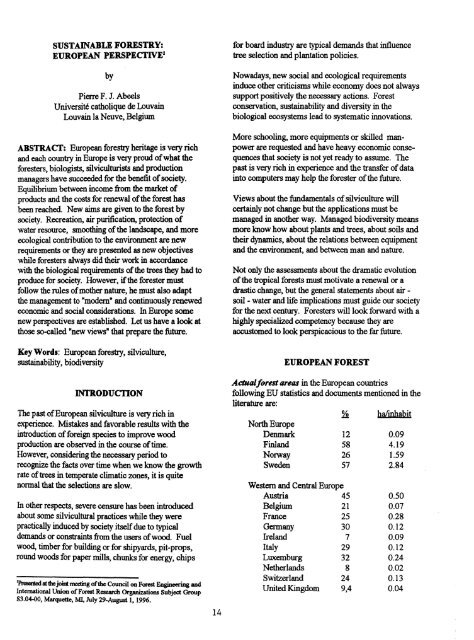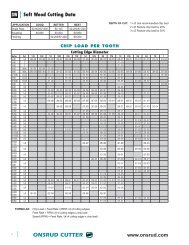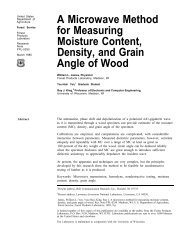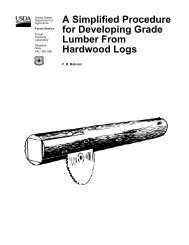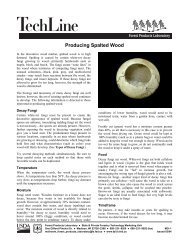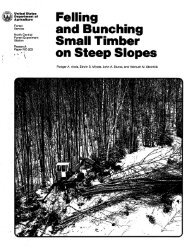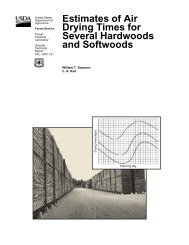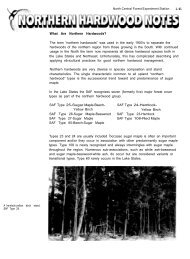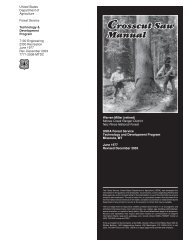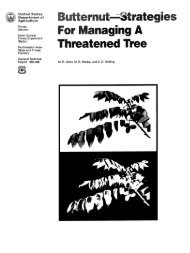Planning and implementing forest operations to achieve ... - Woodweb
Planning and implementing forest operations to achieve ... - Woodweb
Planning and implementing forest operations to achieve ... - Woodweb
You also want an ePaper? Increase the reach of your titles
YUMPU automatically turns print PDFs into web optimized ePapers that Google loves.
SUSTAINABLE FORESTRY:<br />
for board industry are typical dem<strong>and</strong>s that influence<br />
EUROPEAN PERSPECTIVE t tree selection <strong>and</strong> plantation policies.<br />
by<br />
PierreF. J. Abeels<br />
Universit_ catholique de Louvain<br />
Louvain la Neuve, Belgium<br />
Nowadays, new social <strong>and</strong>ecological requirements<br />
induce other criticisms while economy does not always<br />
support positively the necessary actions. Forest<br />
conservation, sustainability <strong>and</strong> diversity in the<br />
biological ecosystems lead <strong>to</strong> systematic innovations.<br />
More schooling, more equipments or skilled man-<br />
ABSTRACT: European <strong>forest</strong>ry heritage is very rich power are requested <strong>and</strong> have heavy economic eonse<strong>and</strong><br />
each country in Europe is very proud of what the<br />
quences that society is not yet ready <strong>to</strong> assume. The<br />
<strong>forest</strong>ers, biologists, silviculturists <strong>and</strong> production<br />
past is very rich in experience <strong>and</strong> the transfer of data<br />
managers have _ed for the benefit of soeiety, in<strong>to</strong> computers may help the <strong>forest</strong>er of the future.<br />
Equilibrium between income from the market of<br />
products <strong>and</strong> the costs for renewal of the <strong>forest</strong> has<br />
Views about the fundamentals of silviculture will<br />
been reached. New aims are given <strong>to</strong> the <strong>forest</strong> by<br />
certainly not change but the applications must be<br />
society. Recreation, air purification, protection of<br />
managed in another way. Managed biodiversity means<br />
water resource, smoothing of the l<strong>and</strong>scape, <strong>and</strong> more more know how about plants <strong>and</strong> trees, about soils <strong>and</strong><br />
ecological contribution <strong>to</strong> the environment are new<br />
their dynamics, about the relations between equipment<br />
requirements or they are presented asnew objectives<br />
<strong>and</strong> the environment, <strong>and</strong> between man <strong>and</strong> nature.<br />
while <strong>forest</strong>ers always did their work in accordance<br />
with the biological requirements of the trees they had <strong>to</strong> Not only the assessments about the dramatic evolution<br />
produce for society. However, if the <strong>forest</strong>er must<br />
of the tropical <strong>forest</strong>s must motivate a renewal or a<br />
follow the rules of mother nature, he must also adapt drastic change, but the general statements about air -<br />
the management <strong>to</strong> "modem"<strong>and</strong> continuously renewed<br />
economic <strong>and</strong> social considerations. In Europe some<br />
soft - water <strong>and</strong> life implications must guide our society<br />
for the next century. Foresters will look forward with a<br />
new perspectives are established. Let us have a look at highly specialized competency because they are<br />
those so-called "new views" that prepare the future,<br />
accus<strong>to</strong>med <strong>to</strong> look perspicacious <strong>to</strong> the far future.<br />
Key Words: European <strong>forest</strong>ry, silviculture,<br />
sustaiaability, biodiversity<br />
EUROPEAN FOREST<br />
Actual <strong>forest</strong> areas in the European countries<br />
INTRODUCTION<br />
following ELI statistics <strong>and</strong>documents mentioned in the<br />
literature are:<br />
The past of European silviculture is very rich in % ha/inhabit<br />
experience. Mistakes <strong>and</strong> favorable results with the<br />
introductionofforeign species<strong>to</strong> improve wood<br />
North Europe<br />
Denmark 12 0.09<br />
production are observed in the course of time. Finl<strong>and</strong> 58 4.19<br />
However, considering the necessary period <strong>to</strong> Norway 26 1.59<br />
recognize the facts over time when we know the growth Sweden 57 2.84<br />
rate of trees in temperate climatic zones, it is quite<br />
normal that the selections are slow.<br />
Western <strong>and</strong> Central Europe<br />
Austria 45 0.50<br />
In other respects, severe censure has been introduced Belgium 21 0.07<br />
about some silvicultural practices while they were France 25 0.28<br />
practically induced by society itself due <strong>to</strong> typical Germany 30 0.12<br />
dem<strong>and</strong>s or constraints from the users of wood. Fuel Irel<strong>and</strong> 7 0.09<br />
wood, timber for building or for shipyards, pit-props, Italy 29 0.12<br />
round woods for paper mills, chunks for energy, chips Luxemburg 32 0.24<br />
Netherl<strong>and</strong>s 8 0.02<br />
Switzerl<strong>and</strong> 24 0.13<br />
'_<br />
International<br />
atfirejoint<br />
Union<br />
meaing<br />
of Forest<br />
of<br />
Research<br />
the Council<br />
Organizations<br />
on Forest Engineering<br />
Subject Group<br />
<strong>and</strong> United Kingdom 9,4 0.04<br />
$3.04-00, Marquette, MI, July 29-August 1, 1996.<br />
14


